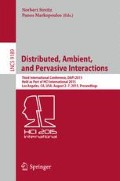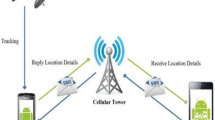Abstract
The issue of loss or kidnapping children has become unfortunately a widespread phenomenon in many countries. To address this issue, this paper presents a children tracking system. It consists of a small device carried by the child and a mobile application that enables the user to track his child movements by tracking that device. That will be done by using GPS and Bluetooth 4.0 technology to track children in indoor and outdoor locations. For indoor, the application searches for the child by detecting the beacon device using Bluetooth 4.0. And for the outdoor locations, the application uses the GPS/GPRS chip.
You have full access to this open access chapter, Download conference paper PDF
Similar content being viewed by others
Keywords
1 Introduction
The issue of missing children in the markets, malls and public places has become a real concern and a major threat to children and their families. Statistics about missing children are shocking. Approximately 100,000 children in Germany, 41,000 children in Canada, and 20,000 children in Spain and Australia are reported missing each year. Also 800,000 children go missing each year in the United States [1]. In India, a child goes missing every eight minutes, 40 % of those children have not been found [2]. Unfortunately, there is a lack of information about the missing children in Saudi Arabia and in the Gulf countries in general, but according to the articles published about this issue, many families have suffered from losing a child and some of them have lost a child for a short duration because he walks away his family and doesn’t know his family name, his home address or his neighborhood which delay their return to their families.
To address this issue, this paper presents a children tracking system. It consists of a small device carried by the child and a mobile application that enables the user to track his child movements by tracking that device. That will be done by using GPS and Bluetooth 4.0 technology for tracking the child in indoor and outdoor locations. For indoor, the application searches for the child by detecting the beacon device using Bluetooth 4.0. And for the outdoor locations, the application uses the GPS/GPRS chip.
The rest of the paper is organized as follows. In Sect. 2, a brief overview of related work is given, followed by the description of the proposed system in Sect. 3. In Sect. 4, results of the usability testing and system testing are discussed. Finally, the Sect. 5 concludes the paper.
2 Related Work
Many systems have been proposed to track and locate children; in some of them researchers use the Global Positioning System (GPS) to locate a child in outdoor places [3–7]. However, GPS and even cell phones are not useful in indoor places. The accuracy of cell phone positioning technology is not sufficient and GPS systems cannot penetrate building and other obstacles. Other systems use alternative technologies for indoor places, such as Bluetooth [8, 9] and RFID [10]. There are many commercial devices used by parents to track and locate their children such as Amber Alert GPS [11], Pocket finder [12], Spark Nano GPS Tracker [13] and iTrail [14].
The proposed and commercialized systems consist of tracking the child’s cell phone or tracking the chip carried by the child to locate him. However they are insufficient because they don’t support commonly the indoor and outdoor tracking. Furthermore, the size of the tracking device for others systems is not suitable for the child. Also these systems are expensive and not all of them support the Arabic language.
3 System Methodology and Design
The proposed children tracking system consists of developing a mobile application that enables users to track their children movements in indoor and outdoor locations. The child holds a small device and the applications tracks that device. That will be done by using GPS and Bluetooth 4.0 technology for tracking the child in indoor and outdoor locations.
For indoor, the application searches for the child by detecting the beacon device using Bluetooth 4.0. Beacons are small wireless devices that transmit small amount of data to other beacons or smart phones by using Bluetooth 4.0 technology. They consume a little amount of energy, can transmit up to 2.4 GHz Bluetooth signals and serve up to 300 feet space. If the child is found, the distance between the child device and the parent’s phone will be displayed on the phone screen. And if the location of the child was not found in the range of Bluetooth 4.0, the application searches the child using GPS/GSM chip. GPS/GSM chip sends an SMS message to the parent’s phone containing child location on Google map, and that what we are using for the outdoor locations. Internet connection is not required for all of the services. The architecture of the proposed system is illustrated in Fig. 1.
- Step 1: :
-
Search for the child by detecting the beacon device using Bluetooth 4.0. If the child is found, the distance between the device carried by the child and the parent’s phone will be displayed.
- Step 2: :
-
If the location of the child was not found in the range of Bluetooth 4.0, the application searches for the child using the GPS/GSM chip, the chip sends an SMS to the parent’s phone containing the child location on Google map.
3.1 Flow Chart Diagram
The flow chart diagram, presented in Fig. 2, shows the logical representation of the find function in child tracking system. It starts by searching for a selected device using Bluetooth. After selecting the device, the search starts using Bluetooth first, if the device is found within the Bluetooth range, the location is displayed. Otherwise, if the device is not found, it means that it is out of the Bluetooth range, so the GPS is used in the search process.
3.2 Graphical User Interfaces
When the user runs the application, he can search for his child or one of his children by clicking on the child’s profile in the list, as shown in Fig. 3. After clicking on a child’s profile, the child’s indoor location will be displayed, as illustrated in Fig. 4(a). If the child is out of the range, the user has to click on GPS button, and another GUI is displayed with the child’s location on Google map, as shown in Fig. 4(b).
4 System Testing
The usability testing of the proposed system was performed by 10 people with different ages; both genders and different level of education. Tasks are given in the Table 1. The goal is to determine whether the application is easy to use and her GUIs are friendly or not. All of users performed the tasks easily and give positive feedbacks.
On the other hand, the system testing has shown that the proposed tracking system is capable to locate the children, carrying the device, in the indoor and outdoor locations.
5 Conclusion and Future Work
In this paper a children tracking system, in indoor and outdoor places, is proposed. It consists of a mobile application and a small device carried by the child. The mobile application enables the user to track and locate his child by locating that device. That will be done by using GPS and Bluetooth 4.0 technologies to track the child in indoor and outdoor locations. For indoor, the application searches for the child by detecting the beacon device using Bluetooth 4.0. And for the outdoor locations, the application uses the GPS/GPRS chip. The system was evaluated by testing its ability to locate the tracked children with accuracy. The evaluation ended successfully with a very high rate of positive outcomes. As future work, the indoor tracking can be improved by extending the distance covered by the system.
References
International Centre for Missing & Exploited Children. http://www.icmec.org
National Crime Records Bureau. http://ncrb.gov.in
Al-Suwaidi, G.B., Zemerly, M.J.: Locating friends and family using mobile phones with global positioning system (GPS). In: IEEE/ACS International Conference on Computer Systems and Applications (2009)
Almomani, I.M., Alkhalil, N.Y., Ahmad, E.M., Jodeh, R.M.: Ubiquitous GPS vehicle tracking and management system. In: IEEE Jordan Conference on Applied Electrical Engineering and Computing Technologies (AEECT), pp. 1–6 (2011)
Chandra, A., Jain, S., Qadeer, M.A.: GPS Locator: An application for location tracking and sharing using GPS for Java enabled handhelds. In: International Conference on Computational Intelligence and Communication Networks (CICN), pp. 406–410 (2011)
Anderson, R.E., et al.: Building a transportation information system using only GPS and basic SMS infrastructure. In: International Conference on Information and Communication Technologies and Development (ICTD). IEEE (2009)
Al-Mazloum, A., Omer, E., Abdullah, M.F.A.: GPS and SMS-based child tracking system using smart phone. Int. J. Electr. Comput. Electron. Commun. Eng. 7(2), 171–174 (2013)
Opoku, S.K.: An indoor tracking system based on bluetooth technology. Cyber J. Multi. J. Sci. Technol. J. Sel. Area. Telecommun. (JSAT) 2(12), 1–8 (2011)
Morii, K., Taketa, K., Mori, Y., Kojima, H., Kohno, E., Inoue, S., Ohta, T., Kakuda, Y.: A new generation children tracking system using bluetooth MANET composed of android mobile terminals. In: 9th International Conference on Ubiquitous Intelligence & Computing and 9th International Conference on Autonomic & Trusted Computing (UIC/ATC), pp. 405–407 (2012)
Al-Ali, A.R., Aloul, F.A., Aji, N.R., Al-Zarouni, A.A., Fakhro, N.H.: Mobile RFID tracking system. In: 3rd International Conference on Information and Communication Technologies: From Theory to Applications ICTTA, pp. 1–4 (2008)
Amber Alert GPS. http://www.amberalertgps.com
Pocket Finder. http://www.pocketfinder.com
Spark GPS. http://sparkgps.com
iTrail. http://itrailgpstracker.com
Author information
Authors and Affiliations
Corresponding author
Editor information
Editors and Affiliations
Rights and permissions
Copyright information
© 2015 Springer International Publishing Switzerland
About this paper
Cite this paper
Taileb, M., Wajdi, W., Hamdi, H., Al-Garni, G., Al-Shehri, S., Al-Marwani, M. (2015). Children Tracking System in Indoor and Outdoor Places. In: Streitz, N., Markopoulos, P. (eds) Distributed, Ambient, and Pervasive Interactions. DAPI 2015. Lecture Notes in Computer Science(), vol 9189. Springer, Cham. https://doi.org/10.1007/978-3-319-20804-6_50
Download citation
DOI: https://doi.org/10.1007/978-3-319-20804-6_50
Published:
Publisher Name: Springer, Cham
Print ISBN: 978-3-319-20803-9
Online ISBN: 978-3-319-20804-6
eBook Packages: Computer ScienceComputer Science (R0)








